Denver-Area Moms Get Shocked at the Spangler Labs
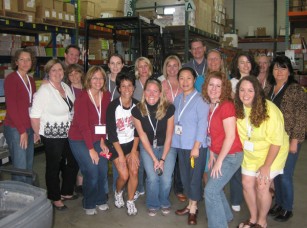
Written by Susan Wells
Over twenty Denver-area home schooling moms visited the Steve Spangler Science laboratories this week for a special Halloween science workshop.
We have never done a workshop specifically for parents. Steve Spangler offers many opportunities for teachers across the country to take part in a science Boot Camp, but this was the first time parents were invited to come to our labs and learn how to bring more science into their lessons.
Steve Spangler offered the workshop as an opportunity to share some Halloween science experiments and activities with the moms (and one dad) to help enhance their science curriculum as well as give them the tools to go out and share with other parents.
After years of doing school science shows and student and teacher workshops, the Spangler Science team has come to understand the essence of what we do – we teach people to be amazing by providing them with products and innovations that are educational, entertaining, and inspire the imagination.
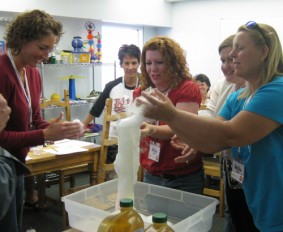 Steve began the workshop by shocking the moms, literally. Steve has a machine that all of us in the office dread…the Sissy Machine. The Sissy Machine is a hand-crank electricity generator. When he hooked the moms up to the Sissy Machine, I cringed. It was very interesting to actually watch the electric current travel through the participants. Everyone jumped and “ooh’d” or “ack’d” as they became human conductors of electricity. I enjoy watching the Sissy Machine in action, but don’t necessarily enjoy being a participant. I wonder if the moms would volunteer again.
Steve began the workshop by shocking the moms, literally. Steve has a machine that all of us in the office dread…the Sissy Machine. The Sissy Machine is a hand-crank electricity generator. When he hooked the moms up to the Sissy Machine, I cringed. It was very interesting to actually watch the electric current travel through the participants. Everyone jumped and “ooh’d” or “ack’d” as they became human conductors of electricity. I enjoy watching the Sissy Machine in action, but don’t necessarily enjoy being a participant. I wonder if the moms would volunteer again.
Everyone received an Energy Ball and learned about the difference between an experiment and using the scientific method. An experiment is an activity that you perform. Using the scientific method involves using an experiment to test a theory. Using the Energy Ball as a tool, instead of an experiment, the moms tested what did and did not conduct electricity.
For example, skin is a great conductor of electricity, but a shirt acts as an insulator.
The workshop continued with glowing, bubbling and oozing dry ice activities. The moms learned how to make spooky Halloween cylinders full of dry ice, dish soap and warm water bubble over. It’s a perfect activity for Halloween that kids (and parents) can’t keep their hands off.
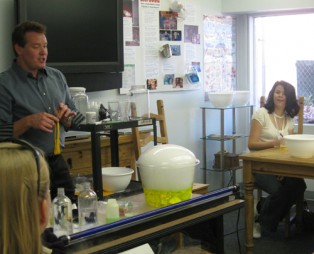 Another favorite was the Crystal Ball Bubble. This demonstration brings out the kid in everyone. Stretch a cloth across a large bowl filled with dry ice and water, and watch a huge bubble form with swirling vapor pools. The best part is when the bubble gets so big, it spills over the sides of the bowl, pops and releases a huge flow of fog. The moms had big eyes and everyone wanted to try to make a bubble, pop it and watch the fog roll off. No one can resist “oooing” and “ahhing” while watching the bubble grow and then burst.
Another favorite was the Crystal Ball Bubble. This demonstration brings out the kid in everyone. Stretch a cloth across a large bowl filled with dry ice and water, and watch a huge bubble form with swirling vapor pools. The best part is when the bubble gets so big, it spills over the sides of the bowl, pops and releases a huge flow of fog. The moms had big eyes and everyone wanted to try to make a bubble, pop it and watch the fog roll off. No one can resist “oooing” and “ahhing” while watching the bubble grow and then burst.
Ghost Boo Bubbles is another irresistible activity. Bounce the ghostly bubbles and watch the fog as they burst in hands.
Steve also reinforced dry ice safety for children and adults. A fun snack at Halloween is to carbonate apple juice with dry ice. Use a caldron and ladle the apple juice to ensure no dry ice gets into the glasses.
The moms also played with disappearing eyeballs (Jelly Marbles), Screaming Balloons and Bleeding Paper.
The workshop wrapped up with a discussion about homeschooling and how Steve Spangler Science better work with home schooling parents to help enrich their childrens’ science education. What do you think are the needs and challenges for home schooling parents in teaching science in their curriculum? Please leave a comment below.
Thank you to all who attended. It was a fun afternoon filled with laughter and learning at the Steve Spangler Science labs. Science should not just be an extracurricular activity or a magic show. It’s a very important part of our children’s education that should not be tread upon lightly. Science toys and tools are important for learning, but learning how to use them and encourage a sense of wonder and exploration is equally important.
If you attended the workshop, we’d love to hear your feedback and comments about it. Please leave us a comment.
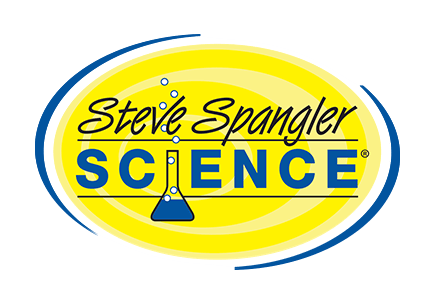


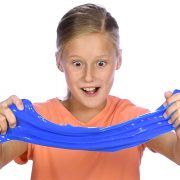

What a great afternoon we had at the workshop! As a former science teacher and now new homeschooling mom, I loved how simple the experiments were and could just imagine the delight in kids faces as they get to play and do science through discovery. I bet it looked like all of ours!
I am thrilled with the available content on your website, too. What a great help to parents and teachers!
I can’t wait to host a fun Halloween party with the great ideas I learned.
Thanks for the generosity of your time, talents, enthusiasm and the great take-away items!
Oh, and about the Sissy Machine? Um. Probably not. 🙂
This is a great idea. Getting parents directly involved and educated in science through experiments and demonstrations sets the table for more hands-on inquiry based learning at home. I teach 5th grade science and would love to do something like this for the parents in our school. By opening their eyes to some science concepts could certainly be a forum for open dialog for parents to use with the students at home. In my community, we are always looking for ways to get parents involved, and this is a wonderful avenue. Do you have any suggestions as to how to implement something like this for elementary parents? How do I go about choosing content and demonstrations that are easy for the parents to understand yet can create an open dialog for communication with the students at home?
Thank you for your time and great ideas!
Thank you so much to the Steve Spangler team for doing this. I feel so lucky to have had the opportunity to attend.
I stopped on my way home from the class and bought dry ice. That night I dropped some in a bowl on the kitchen table as a centerpiece. It made such a great topic of conversation as the kids watched it and wondered about how it was working.
The energy ball has been a HUGE hit in our house. Just to see the spark on their faces when they made the connection to the current was priceless. They really understand electrical current from one small little “toy”.
Steve is an inspiring man! Thank you again!
Thank you Steve for your inspiration. I have been thinking about ways to reach more students who school at home. There are many homeschool co-ops which might be a way to reach out. Home schooling is so grassroots, it is hard to hit large groups. Maybe it would be awesome to have a homeschooling science fair. The experience could have a kick off event online so that students could get inspired to discover and explore. Then the “big night” could have students coming with their findings and perhaps you could share some of your pizazz with parents and students together. Can’t you just see families coming from all around the state for this? I’ll keep thinking!